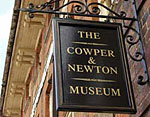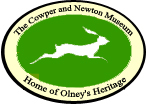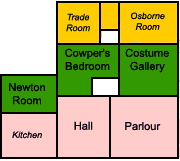|
The Cowper and Newton Museum
|
|
Virtual Tour: The Costume Gallery
|
 |
Mary Unwin
The Costume Gallery was her room
|
|
| View of the Costume Gallery |
 |
|
 |
Mary Unwin's Bobbin Winder |
|
| Cowper's waistcoat
is displayed on the small table beside his cane. It was the one he was wearing when he died. Behind it is a dark wool great-coat with velvet collar owned by William Cowper at the end of his life.
|
 |
|
 |
Rev. William Bull
William Bull, the Independent Minister in Newport Pagnell, was a friend of John Newton. Before he left Olney for London, Newton persuaded Cowper to receive Bull.
|
|
Cowper enjoyed Bull's company and soon Bull was dining with Cowper once a fortnight. In a letter to William Unwin Cowper described Bull:
A Dissenter, but a Liberal one; a man of letters and of genius, a master of fine imagination ...which, when he finds himself in the company he loves and can confide in, runs away with him into such fields of speculation as amuse and enliven every other imagination that has the happiness to be of the party. At other times he has a tender and delicate sort of melancholy in his disposition, not less agreeable in its way. No men are better qualified for companions in such a world as this than men of such a temperament. ...He can be lively without levity, and pensive without objection. Such a man is Mr. Bull. But he smokes tobacco! Nothing is perfect. Nihil est ab omni parte beatum.
Because Bull was a pipe-smoker, Cowper usually entertained him in the Summer House in the garden. Bull once left his tobacco box at Orchard Side. He received it back from Cowper the next day with verses written by the poet in praise of the supposed nymph of the river where his Orinoco tobacco grew:
So may thy votaries increase
And fumigation never cease.
May Newton with renew'd delights
Perform thine odoriferous rites
While clouds of incense half divine
Involve thy disappearing shrine,
And so may smoke-inhaling Bull
Be always filling, never full.
|
Rev. William Bull's travelling cloak
The red lined caped travelling cloak belonged to the Rev. William Bull. This brown cloak has a waist length cape with additional shoulder protection and a velvet collar. Bull wore this cloak during his tour of Scotland in 1780 "in a chaise drawn by four horses", accompanied by a Mr. Thornton.
|
 |
|
 |
Mrs. Bull's wedding dress
Mrs. Hannah Bull, neé Palmer, married Rev. William Bull on 7th June 1768. She was the daughter of Thomas Palmer of Bedford. The dress is made of a fine embroidered fabric. The embroidery is not thought to be hand done. The front of the underskirt is decorated with two flounces, while the overskirt is attached to the bodice, the front edges of the overskirt/train being decorated with an attached frill. The centre front of the bodice is decorated with pleated frills. The sleeves culminate in a three tier pointed elbow frill. The dress is lavishly trimmed with matching braid.
|
|
| Lady Austen's presentation dress
Now much faded, this timy dress was originally a deep russet red. It was the court presentation dress worn by Lady Austen when she was presented at court to King George III. It was cut down in the 1920s for a child of the Grindon family.
The underskirt has a frill all round the lower edge and the overskirt extends into a train. The bodice is laced and would probably have had a deep lace collar and cuffs.
|
 |
|
 |
Lady Austen
She was born Ann Richardson in 1736. In 1755, aged 19, she married Robert Austen, who was very much older than her. They moved to France in 1763, returning to England four years later.
In 1767 she became an Evangelical and on her return to France in 1768 she took with her Evangelical literature including the works of James Hervey, a favourite author of William Cowper.
The Austens returned to England in 1771 and the following year Sir Robert died at the age of 64.
In 1773 the widowed Lady Austen was thinking of settling in Olney to be near her sister, Mrs. Jones, who was the wife of the curate at Clifton Reynes.
|
|
However, she returned to France in 1774 and from 1778 resided in London. It was not until 1781 that, on a visit to her sister, she first met William Cowper, who wrote:
She is a lively agreeable woman, has seen much of the World and ...she laughs and makes laugh
|
| Lady Austen's Fan |
 |
|
Lady Austen was also much taken with Cowper and decided to settle in Olney but first returned to London from where she kept up a correspondence with him. She missed Cowper as much as he missed her company. He wrote:
This page of Providence quite new,
And now just opening to our view,
Employs our present thoughts and pains,
To guess, and spell, what it contains."
Lady Austen hinted very strongly at marriage. It seems likely that Mary Unwin became rather jealous. At any rate Cowper wrote to dissuade Lady Austen. However, she didn't give up and on her return to Clifton Reynes in 1782 renewed the acquaintance. In October 1783 she set up home in the vicarage which she had arranged to rent. She influenced Cowper to write "John Gilpin" and "The Task". During 1784, however, Cowper became increasingly resentful of Lady Austen's demands on his time, complaining that he could not write any more. Lady Austen took herself off to Bath in May 1784, possibly hoping that, by her absence, she would force Cowper's hand. However, it was a gamble that she lost. By July 1784 the friendship was broken off possibly after Lady Austen wrote to Cowper promising to devote her life and fortune to him. She returned to Clifton Reynes, residing there from 1785 -1790. In 1790 she returned to London and six years later she married a French count and poet and ended her days in France.
|
| Lady Austen's 'Golden Treasury'
On the frontespiece of this book is handwritten:
This book belongs to Ann Austen, November 1770
This is a mistake since the book was published in 1778.
|
 |
|
 |
Sofa with Cowper's bedspread draped over it
It was on this sofa that Cowper sat beside Lady Throckmorton and read her his poems.
|
|
| The Throckmorton family lived at Weston Hall and owned the nearby Weston Lodge which they urged Cowper and Mary Unwin to rent. The move to Weston Underwood in the autumn of 1786 was prompted by Cowper's cousin Lady Hesketh (sister of Theodora). She felt Cowper would be in better company if he moved to Weston Lodge where he could socialise with the Throckmortons. Rev. John Newton was not so enthusiastic about Cowper's new friends for they were Roman Catholic. |
You are in Costume Gallery
Click on the hare to continue the guided tour

or use the floorplan to move to another room
|
|
|
|
|
|














